Are you planning a trip to Vietnam and seeking reliable transportation and tour options? SIXT.VN offers seamless travel solutions, from airport transfers to customized Hanoi tours, ensuring a memorable experience. This article explores the fascinating world of molecular rotors and their movements, providing insights into nanoscale mechanical devices. Explore Vietnam with SIXT.VN.
1. Understanding Molecular Rotors: What Happens When a Particle Is Constrained to Travel Along the Path?
When a particle is constrained to travel along a specific path, it can induce directed motion in molecular rotors, even without net angular momentum transfer. This directed motion arises from the particle exerting a torque upon entering and exiting the molecular wire, causing rotation as it traverses the path.
Exploring the Dynamics
Molecular rotors are nanoscale devices capable of rotational motion, often driven by electrical currents or other external stimuli. These rotors are typically composed of molecules engineered to rotate around a specific axis, similar to a tiny motor. Their behavior is dictated by principles of physics, chemistry, and materials science. Several factors influence the motion of the rotor when a particle is constrained to travel along a path, including:
- The Path’s Geometry: The shape and structure of the path significantly influence the particle’s movement and the torque exerted on the rotor.
- Particle Properties: The mass, charge, and velocity of the particle affect the amount of energy and momentum transferred to the rotor.
- External Forces: Applied electric fields, magnetic fields, or mechanical forces can influence the rotor’s motion.
Importance of Molecular Rotors
Molecular rotors hold promise for various applications, including:
- Molecular Machines: Constructing complex mechanical devices at the nanoscale.
- Data Storage: Utilizing rotational states to store information.
- Drug Delivery: Controlling the release of drugs through rotational motion.
2. What Are the Key Parameters Influencing the Rotation of a Particle Constrained on a Path?
Several key parameters influence the rotation of a particle constrained to move along a path, including the particle mass, the path’s geometry (radius and number of turns), the moment of inertia of the path, and any potential barriers hindering the motion. These parameters determine the threshold current needed to initiate and sustain rotation.
Delving into the Parameters
To understand the rotation, it’s essential to consider the parameters that play a crucial role:
| Parameter | Description | Influence on Rotation |
|---|---|---|
| Particle Mass (m) | The mass of the particle moving along the path. | A larger particle mass typically results in a greater torque exerted on the path, facilitating rotation. |
| Path Geometry (R, N) | The characteristic radius (R) and the number of turns (N) of the path. | A larger radius and greater number of turns increase the interaction time between the particle and the path, enhancing the transfer of angular momentum and promoting rotation. |
| Moment of Inertia (Θ) | The moment of inertia of the path, reflecting its resistance to rotational acceleration. It is related to the characteristic radius as MR^2, where M is the mass of the path. | A smaller moment of inertia allows the path to accelerate more easily, resulting in a higher angular velocity for a given torque. |
| Potential Barrier (ΔV) | The difference between the minimum and maximum potential energy that hinders the rotation of the path. | A higher potential barrier requires more energy for the particle to overcome, thus increasing the threshold current needed to initiate and sustain rotation. |
| Impact Velocity (v0) | The initial velocity of the particle as it enters the path. | A higher impact velocity can provide more energy for the particle to overcome the potential barrier and initiate rotation, but it must be balanced against the time spent within the curved path, as excessive speed can diminish the effect. |
| Mass Ratio (μ = m/M) | The ratio of the particle mass (m) to the mass of the path (M), which influences the collision characteristics and the efficiency of angular momentum transfer. | A higher mass ratio generally leads to a more significant transfer of angular momentum from the particle to the path, making it easier to induce rotation. |
| Particle Current (I) | The number of particles passing through the path per unit time. | A higher particle current can provide a sustained torque on the path, compensating for any energy losses due to friction or potential barriers, and ensuring continuous rotation. |
| Path Chirality | Whether the path is chiral (lacks reflection symmetry). | A chiral path can result in a directional rotation even if the net transfer of angular momentum of the transmitted particles is zero. The sign of the turn is determined by the chirality sign. |
| Exit Radius (ρF) | The radius of the path at the exit point; if ρF is nonzero, the particle transfers angular momentum to the path as it leaves, influencing rotation. | If the exit radius is nonzero, the exit of the particle imparts a net torque on the path, directly influencing its angular momentum and rotational characteristics. Higher exit radii typically result in a more pronounced effect on the rotation of the path. |
| Dwell Time (δτ) | The time a particle spends within the curved path, influencing the interaction between the particle and the path. | A longer dwell time allows for a greater transfer of momentum and energy, increasing the likelihood of initiating and sustaining rotation. This effect is particularly notable in paths with a helical geometry. |
| Temperature (T) | The operating temperature of the system, which affects the thermal fluctuations and the energy required to overcome potential barriers. | At higher temperatures, increased thermal fluctuations can disrupt the directed rotation of the rotor. The system’s energy must significantly exceed the thermal energy (kT) for stable, directed motion. |
| Friction (γ) | The frictional forces acting on the path, which can dissipate energy and hinder rotation. | Higher friction coefficients require greater energy input to maintain rotation, affecting the threshold current and the overall efficiency of the rotor. |
| External Fields (E, B) | Applied electric or magnetic fields that exert forces on the particle or the path. | Electric fields can accelerate charged particles along the path, while magnetic fields can exert torque directly on magnetic rotors. These fields can significantly influence the rotation dynamics and can be used to control the rotor’s motion. |
By understanding and controlling these parameters, scientists and engineers can design and optimize molecular rotors for specific applications in nanotechnology and other fields.
SIXT.VN: Your Gateway to Seamless Travel in Vietnam
Navigating a new country can be challenging, especially when planning transportation and activities. SIXT.VN offers a range of services designed to make your trip to Vietnam smooth and enjoyable.
- Airport Transfers: Ensure a hassle-free start to your journey with reliable airport pickup and drop-off services.
- Hotel Bookings: Find the perfect accommodation to suit your needs and budget with SIXT.VN’s comprehensive hotel booking service.
- Hanoi Tours: Explore the cultural and historical highlights of Hanoi with expertly guided tours tailored to your interests.
- Flight Bookings: Get the best deals on flights to and from Vietnam, making travel planning more accessible.
3. How Does Chirality Influence the Motion of a Particle Constrained on a Path?
Chirality, or handedness, plays a crucial role in determining the directionality of the rotation of a particle constrained on a path. When the path lacks reflection symmetry, the rotation becomes directional, with the sign of the rotation determined by the chirality of the path.
The Role of Chirality
Chirality, or handedness, is a property of a molecule that lacks reflection symmetry, meaning it cannot be superimposed onto its mirror image. This characteristic is crucial in determining the directionality of the rotation of a particle constrained on a path.
Impact on Molecular Rotors:
- Directed Motion: In chiral paths, the rotation becomes directional, meaning it consistently rotates in one direction rather than oscillating randomly.
- Sign Determination: The sign of the rotation, whether it’s clockwise or counterclockwise, is determined by the chirality of the path. A right-handed helix will rotate in one direction, while a left-handed helix will rotate in the opposite direction.
- Symmetry Breaking: Chirality breaks the symmetry of the system, leading to a preferred direction of rotation. Without chirality, the rotation might be undirected or require other symmetry-breaking mechanisms.
Consequences of Chirality:
- Molecular Machines: Chiral molecular rotors can be used to build nanoscale machines that perform specific tasks with directional movements.
- Spin-Selective Transport: Helical molecular wires, which are chiral, have been reported to exhibit spin-selective transport, a phenomenon known as chirality-induced spin selectivity (CISS). This can have significant implications for spintronics.
Theoretical Explanation:
- Torque Generation: When a particle moves along a chiral path, it experiences forces that generate a torque. This torque results in a net rotation of the path.
- Angular Momentum: The chirality ensures that the angular momentum transferred to the path is consistently in one direction, leading to a directed rotation.
Plan Your Perfect Hanoi Getaway with SIXT.VN
If you’re planning a trip to Hanoi, SIXT.VN is your ultimate resource for creating a memorable and stress-free travel experience. With various services tailored to meet your needs, SIXT.VN ensures that every aspect of your journey is seamless and enjoyable.
Comprehensive Travel Services
- Customized Hanoi Tours: Explore the best of Hanoi with our expert-guided tours. From historical landmarks to vibrant street food scenes, immerse yourself in the rich culture of this fascinating city.
- Airport Transfer Services: Start your trip with ease by booking our reliable airport transfer services. Arrive at your destination comfortably and on time.
- Flexible Hotel Booking: Choose from a wide range of hotels that fit your budget and preferences. Whether you’re looking for luxury accommodations or a cozy stay, we’ve got you covered.
4. What Is the Role of Angular Momentum in Current-Induced Rotation?
Angular momentum plays a pivotal role in current-induced rotation of molecular rotors, especially when the incoming or outgoing current carries a non-vanishing angular momentum. In such scenarios, rotation arises directly due to the angular momentum transfer, often referred to as the “garden hose effect.”
Exploring Angular Momentum Transfer
Angular momentum is a crucial factor in understanding the current-induced rotation of molecular rotors. This is especially true when the incoming or outgoing current has a non-zero angular momentum.
Key Concepts:
- Angular Momentum Conservation: In a closed system, the total angular momentum remains constant. When a particle moves along a path, it can transfer angular momentum to the path, causing it to rotate.
- Garden Hose Effect: If the incoming or outgoing current carries a non-zero angular momentum, the rotation arises directly from this transfer. This is analogous to how a garden hose recoils when water is expelled from the nozzle.
Scenarios:
- Non-Vanishing Angular Momentum: In molecular junctions, if the incoming or outgoing current has a non-zero angular momentum, it directly induces rotation. This is common in setups where the molecule is not symmetrically bound to the electrodes.
- Vanishing Angular Momentum: Even if the net transfer of angular momentum is zero, the path can still rotate if it is chiral. In this case, the particle exerts a torque upon entering and exiting the molecular wire.
Factors Influencing Angular Momentum Transfer:
- Path Geometry: The shape of the path affects how angular momentum is transferred. Helical paths, for example, can efficiently convert linear motion into rotational motion.
- Particle Properties: The mass, charge, and velocity of the particle influence the amount of angular momentum it can transfer.
- External Fields: Applied electric or magnetic fields can alter the angular momentum of the particles, affecting the rotation of the path.
Applications:
- Molecular Motors: Understanding angular momentum transfer is crucial for designing efficient molecular motors that can perform useful work.
- Spintronics: The interplay between angular momentum and spin in chiral molecules has implications for spintronics, where the spin of electrons is used to carry information.
Discover Unforgettable Experiences with SIXT.VN
SIXT.VN not only provides essential travel services but also opens the door to unforgettable experiences in Vietnam.
Must-Try Activities in Hanoi
- Explore Hanoi’s Old Quarter: Wander through the narrow streets, sample local delicacies, and shop for unique souvenirs. Our guided tours will ensure you don’t miss any hidden gems.
- Visit Hoan Kiem Lake: Enjoy the serene beauty of Hoan Kiem Lake and learn about its legendary history. This iconic landmark is a must-see for any visitor.
- Attend a Water Puppet Show: Immerse yourself in traditional Vietnamese culture with a captivating water puppet show. This unique art form is a delight for all ages.
5. What Are the Potential Applications of Understanding Particle Motion in Constrained Paths?
Understanding particle motion in constrained paths has significant potential applications in developing nanoscale devices for information storage, molecular machines, and controlled drug delivery systems. The ability to control and direct motion at the molecular level opens new avenues for technological innovation.
Real-World Applications
The understanding of particle motion in constrained paths opens up a wide range of potential applications, particularly in the realm of nanotechnology.
Key Applications:
- Nanoscale Information Storage: Molecular rotors can be used as bits in information storage devices. By controlling the rotation of the molecule, it is possible to store data at extremely high densities.
- Molecular Machines: Molecular rotors can serve as components in more complex molecular machines. These machines could perform tasks such as moving materials, catalyzing reactions, or converting energy.
- Controlled Drug Delivery Systems: Molecular rotors can be used to control the release of drugs within the body. By designing rotors that respond to specific stimuli, drugs can be delivered precisely to the desired location and at the right time.
Technological Innovation:
- Sensors: Molecular rotors can be used to create highly sensitive sensors that detect changes in their environment. For example, a rotor could be designed to change its rotational speed in response to the presence of a specific molecule.
- Energy Conversion: Molecular rotors can be used to convert mechanical energy into electrical energy, or vice versa. This could lead to new types of energy harvesters or actuators.
Specific Examples:
- Molecular Switches: By controlling the rotation of a molecule, it can be switched between different states, allowing it to act as a switch in a nanoscale circuit.
- Nanoscale Pumps: Molecular rotors can be used to pump fluids through nanoscale channels, enabling new types of microfluidic devices.
Further Research and Development:
- Material Science: Developing new materials that exhibit specific rotational properties.
- Engineering: Designing and optimizing molecular rotors for specific applications.
Discover the Best of Hanoi with SIXT.VN
Maximize your visit to Hanoi by utilizing SIXT.VN to explore the city’s best attractions and experiences.
Top Hanoi Destinations
- Temple of Literature: Immerse yourself in Vietnam’s rich academic history at the Temple of Literature, the country’s first university. Explore well-preserved courtyards, ancient architecture, and serene gardens.
- Ho Chi Minh Mausoleum: Pay respects to the iconic leader of Vietnam at the Ho Chi Minh Mausoleum. This solemn site offers a glimpse into the nation’s reverence for its founding father.
- Dong Xuan Market: Experience the bustling atmosphere of Hanoi’s largest market. Browse through a wide array of goods, from fresh produce to textiles, and savor local street food.
Why Choose SIXT.VN for Your Hanoi Experience?
- Reliable and Efficient Services: We prioritize your comfort and convenience, ensuring prompt and dependable service.
- Expert Local Knowledge: Benefit from our deep understanding of Hanoi and its surroundings, ensuring an authentic and enriching travel experience.
- Customizable Travel Solutions: Tailor your trip to meet your specific interests and needs, ensuring a personalized adventure.
FAQ About Particle Motion in Constrained Paths
1. What is a molecular rotor?
A molecular rotor is a nanoscale device that exhibits rotational motion, often driven by external stimuli like electrical currents. These rotors are typically composed of molecules engineered to rotate around a specific axis, functioning similarly to a tiny motor.
2. How does constraining a particle to a path induce rotation?
When a particle is forced to travel along a specific path, it can exert a torque on the path, causing it to rotate. This is particularly effective if the path is chiral (lacks reflection symmetry), leading to directional rotation.
3. What parameters influence the rotation of a constrained particle?
Key parameters include the particle’s mass, the path’s geometry (radius and number of turns), the moment of inertia of the path, potential barriers hindering motion, and the initial velocity of the particle. These factors determine the threshold current needed to initiate and sustain rotation.
4. How does chirality affect the direction of rotation?
Chirality, or handedness, plays a crucial role in determining the directionality of the rotation. When the path lacks reflection symmetry, the rotation becomes directional, with the sign of the rotation determined by the path’s chirality.
5. What is the “garden hose effect” in molecular rotors?
The “garden hose effect” refers to scenarios where rotation arises directly due to the angular momentum transfer from the incoming or outgoing current. This occurs when the current carries a non-vanishing angular momentum.
6. What are the potential applications of understanding particle motion in constrained paths?
Potential applications include developing nanoscale devices for information storage, creating molecular machines, and designing controlled drug delivery systems. The ability to control and direct motion at the molecular level opens new avenues for technological innovation.
7. How can molecular rotors be used for information storage?
Molecular rotors can be used as bits in information storage devices. By controlling the rotation of the molecule, it is possible to store data at extremely high densities.
8. What role do external fields play in controlling molecular rotors?
Applied electric or magnetic fields can influence the motion of particles or the path itself, allowing for precise control over the rotor’s motion. Electric fields can accelerate charged particles, while magnetic fields can exert torque directly on magnetic rotors.
9. What is chirality-induced spin selectivity (CISS)?
Chirality-induced spin selectivity (CISS) is a phenomenon observed in helical molecular wires, where spin-selective transport occurs. This has significant implications for spintronics, where the spin of electrons is used to carry information.
10. How does temperature affect the performance of molecular rotors?
Temperature affects the thermal fluctuations within the system. Increased thermal energy can disrupt the directed rotation of the rotor, requiring the system’s energy to significantly exceed the thermal energy (kT) for stable, directed motion.
SIXT.VN: Your Travel Partner in Vietnam
SIXT.VN is your go-to resource for planning a seamless and enjoyable trip to Vietnam, particularly Hanoi. From airport transfers to customized tours, we offer a range of services designed to enhance your travel experience. Contact us today to start planning your adventure.
Address: 260 Cau Giay, Hanoi, Vietnam
Hotline/Whatsapp: +84 986 244 358
Website: SIXT.VN
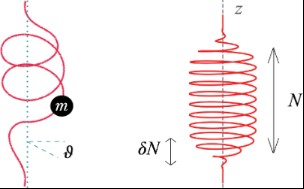 Hanoi Street Food
Hanoi Street Food
Alt: A particle of mass m is constrained to move along a path (red curve) with a defined axis allowing rotation, illustrating a core concept in molecular rotor dynamics.
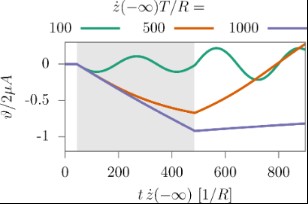 Molecular Rotor Diagram
Molecular Rotor Diagram
Alt: Time evolution of the angle of a 50-helix after a collision with a particle at varying impact velocities, demonstrating the effects of energy transfer and motion constraints in molecular dynamics.
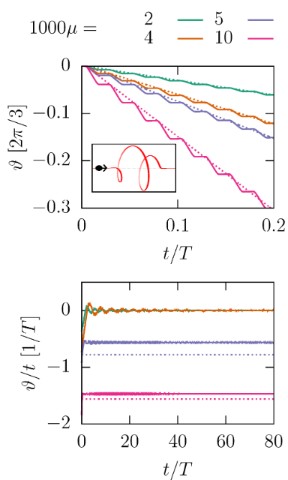 Time Evolution of Angle
Time Evolution of Angle
Alt: Detailed graph showing the time evolution of the angle of a path, with a 1.5-helix under a current, for different mass ratios and impact velocities, illustrating the directed motion caused by torque and angular momentum.
 Helix Revolution Counterclockwise
Helix Revolution Counterclockwise
Alt: Average angular velocity of a helix under a mass current for various mass ratios, showing the relationship between mass current and rotational speed, essential for optimizing molecular rotor performance.
 Angular Velocity Over Time
Angular Velocity Over Time
Alt: Time evolution of angular velocity for a path with ρF = R, demonstrating the transition from bound to unbound motion as a function of mass ratio in a molecular dynamics context.
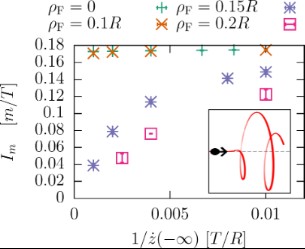 Impact Velocity vs. Threshold Current
Impact Velocity vs. Threshold Current
Alt: Graph of threshold mass current as a function of impact velocity for different exit radii, displaying the energy dynamics and conditions necessary for sustained molecular motion.
 Momentum Current Analysis
Momentum Current Analysis
Alt: Velocity dependence of the threshold momentum current, depicting how the large-velocity limit is influenced by angular momentum boosts, crucial for the directed design of molecular rotors.
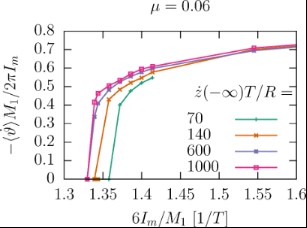 Angluar Velociity and Mass Current
Angluar Velociity and Mass Current
Alt: Correlation between velocity and angular velocity, average of a path exposed to a mass current, revealing the impact of lowered velocities on the threshold current and overall system dynamics.
 Mass Ratio vs Helix Length
Mass Ratio vs Helix Length
Alt: Threshold mass ratio analysis for an unbound directed motion as a function of the helix length and impact velocity, informing design strategies for optimized nanoscale devices.



